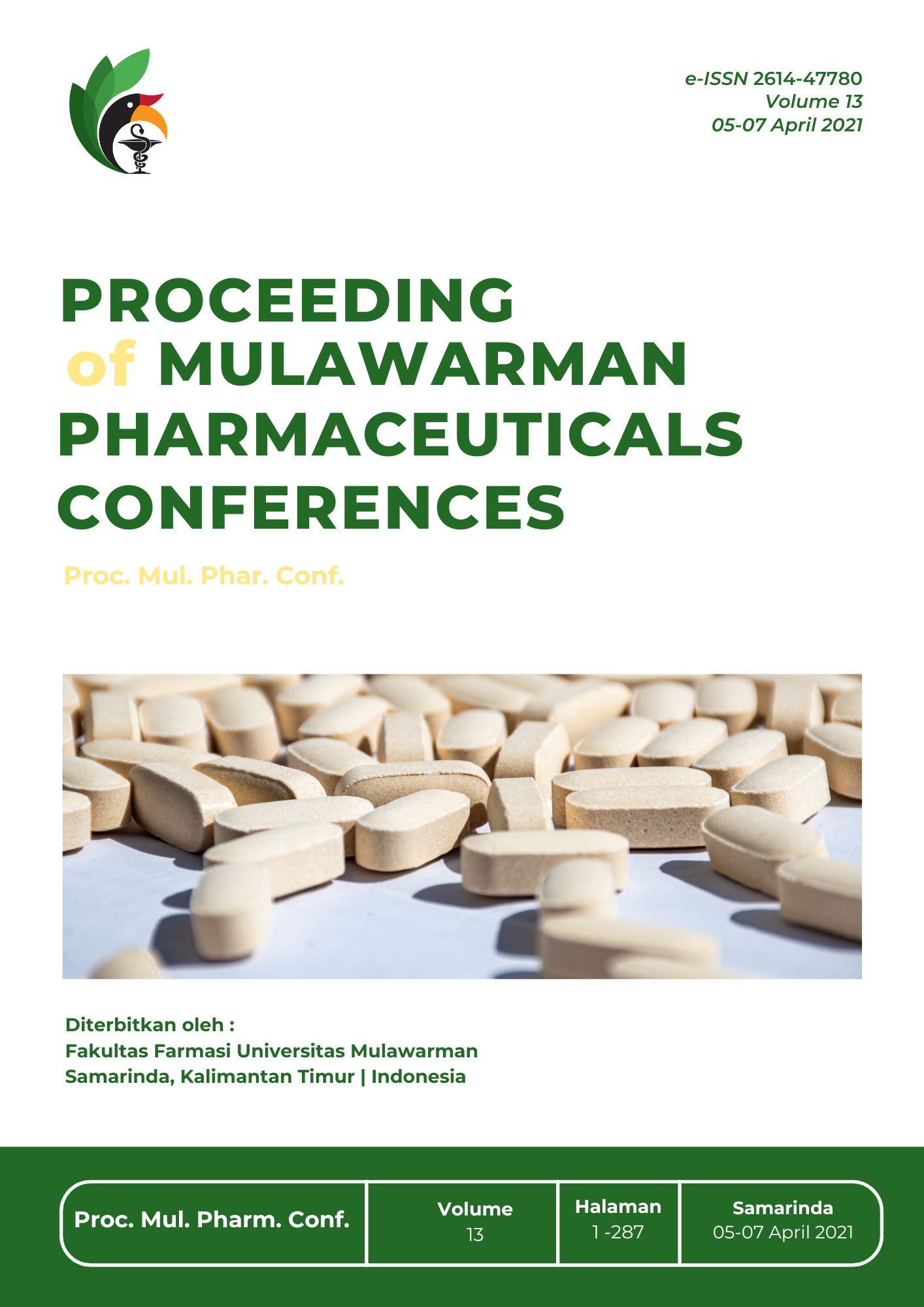Review: Flavonoid Compounds in Orthosiphon stamineus
DOI:
https://doi.org/10.30872/mpc.v13i.400Keywords:
Orthosiphon stamineus, purple variety, white variety, flavonoidsAbstract
Orthosiphon stamineus has long been used in traditional medicine in East India, Indo China, Southeast Asia, and tropical Australia, where this plant is usually found. Based on the color of the flowers and petals, Orthosiphon stamineus is classified into two varieties: white flowers (white varieties) and purple flowers (purple varieties). Orthosiphon stamineus has traditionally been used to treat hypertension, diabetes, bladder and kidney disorders, gallstones, gout, and rheumatism. The leaves of Orthosiphon stamineus were introduced to Europe and Japan as tea for health. The main compounds possessed by Orthosiphon stamineus are rosmarinic acid, eupatorium, and sinensetin. In addition, several studies have isolated the plant of Orthosiphon stamineus. This journal review aims to review studies related to the content of secondary metabolites, traditional uses, pharmacological activities, and levels of flavonoids contained in plants.
References
1] Gimbun J, Pang SF, Yusoff MM. Orthosiphon stamineus (Java Tea). Elsevier Inc.; 2018. doi:10.1016/b978-0-12-812491-8.00047-3
[2] Silalahi M. Orthosiphon stamineus Benth (Uses and Bioactivities). Indones J Sci Educ. 2019;3(1):26. doi:10.31002/ijose.v3i1.729
[3] Ameer OZ, Salman IM, Asmawi MZ, Ibraheem ZO, Yam MF. Orthosiphon stamineus: traditional uses, phytochemistry, pharmacology, and toxicology. J Med Food. 2012;15(8):678-690. doi:10.1089/jmf.2011.1973
[4] Engku Hasmah EA, Ahmad Tarmizi S, Noor Ismawaty N, Abdul Ghani O. Total phenolic, total flavonoid and rosmarinic acid contents in Orthosiphon stamineus (Misai Kucing) in relation to storage conditions. Acta Hortic. 2013;1012:837-842. doi:10.17660/ActaHortic.2013.1012.113
[5] Tezuka Y, Stampoulis P, Banskota AH, et al. Constituents of Vietnamese Medicinal Plant Orthosiphon stamineus. Chem Pharm Bull. 2000;(43):2091.
[6] Miller AL. Antioxidant flavonoids: Structure, function and clinical usage. Altern Med Rev. 1996;1(2):103-111.
[7] Trisilawati O. respon tiga varietas kumis kucing (Orthosipon aristatus) terhadap mikoriza arbuskula. Bul Penelit Tanam Rempah dan Obat. 2005;16(1):18-26. doi:10.21082/bullittro.v16n1.2005.
[8] Keng CL, Siong LP. Morphological Similarities and Differences between the Two Varieties of Cat’s Whiskers (Orthosiphon stamineus Benth.) grown in Malaysia. Int J Bot. 2006. doi:10.3923/ijb.2006.1.6
[9] Almatar M, Rahmat Z, Salleh F. Preliminary morphological and anatomical study of Orthosiphon stamineus. Indian J Pharm Biol Res. 2013;1:1-6. doi:10.30750/ijpbr.1.4.1
[10] Yam MF, Mohamed EAH, Ang LF, et al. A Simple Isocratic HPLC Method for the Simultaneous Determination of Sinensetin, Eupatorin, and 3’-hydroxy-5,6,7,4’-tetramethoxyflavone in Orthosiphon stamineus Extracts. JAMS J Acupunct Meridian Stud. 2012;5(4):176-182. doi:10.1016/j.jams.2012.05.005
[11] Mohamed EAH, Yam MF, Ang LF, Mohamed AJ, Asmawi MZ. Antidiabetic properties and mechanism of action of Orthosiphon stamineus Benth bioactive sub-fraction in streptozotocin-induced diabetic rats. J Acupunct Meridian Stud. 2013;6(1):31-40. doi:10.1016/j.jams.2013.01.005
[12] Hossain MA, Mizanur Rahman SM. Isolation and characterisation of flavonoids from the leaves of medicinal plant Orthosiphon stamineus. Arab J Chem. 2015;8(2):218-221. doi:10.1016/j.arabjc.2011.06.016
[13] Berim A, Gang DR. Methoxylated flavones: occurrence, importance, biosynthesis. Phytochem Rev. 2016;15(3):363-390. doi:10.1007/s11101-015-9426-0
[14] Hossain MA, Ismail Z. Quantification and enrichment of sinensetin in the leaves of Orthosiphon stamineus. Arab J Chem. 2016;9:S1338-S1341. doi:10.1016/j.arabjc.2012.02.016
[15] Adam Y, Somchit MN, Sulaiman MR, et al. Diuretic properties of Orthosiphon stamineus Benth. 2009;124:154-158. doi:10.1016/j.jep.2009.04.014
[16] Manshor NM, Dewa A, Asmawi MZ, Ismail Z, Razali N, Hassan Z. Vascular reactivity concerning Orthosiphon stamineus benth-mediated antihypertensive in aortic rings of spontaneously hypertensive rats. Int J Vasc Med. 2013;2013.
[17] Tabana YM, Al-Suede FSR, Ahamed MBK, et al. Cat’s whiskers (Orthosiphon stamineus) tea modulates arthritis pathogenesis via the angiogenesis and inflammatory cascade. BMC Complement Altern Med. 2016;16(1):480. doi:10.1186/s12906-016-1467-4
[18] Akowuah GA, Zhari I, Norhayati I, Sadikun A, Khamsah SM. Sinensetin, eupatorin, 3?-hydroxy-5, 6, 7, 4 ?-tetramethoxyflavone and rosmarinic acid contents and antioxidative effect of Orthosiphon stamineus from Malaysia. Food Chem. 2004;87(4):559-566. doi:10.1016/j.foodchem.2004.01.008
[19] Halim NH, Pauzi N, Hamil SHR, Shafaei A, Ismail Z, Mohd KS. Standardization of Orthoshiphon stamineus Raw Material and Extracts for Anti-Uterine Fibroid. 2017;9(4):512-515.
[20] Hossain MA, Ismail Z, Rahman A, Kang SC. Chemical composition and anti-fungal properties of the essential oils and crude extracts of Orthosiphon stamineus Benth. Ind Crops Prod. 2008;27(3):328-334. doi:10.1016/j.indcrop.2007.11.008
[21] Alshawsh M, Abdulla M, Ismail S, et al. Free Radical Scavenging, Antimicrobial and Immunomodulatory Activities of Orthosiphon Stamineus. Vol 17.; 2012. doi:10.3390/molecules17055385
[22] Ripim NSM, Fazil N, Ibrahim SNK, et al. Antiviral properties of Orthosiphon stamineus aqueous extract in herpes simplex virus type 1 infected cells. Sains Malaysiana. 2018;47(8):1725-1730. doi:10.17576/jsm-2018-4708-11
[23] Alshawsh MA, Abdulla MA, Ismail S, Amin ZA. Hepatoprotective Effects of Orthosiphon stamineus Extract on Thioacetamide-Induced Liver Cirrhosis in Rats. Evid Based Complement Alternat Med. 2011;2011:103039. doi:10.1155/2011/103039
[24] Markham K. Techniques of Flavonoids Identifiction. Academic Press Inc. (London) Ltd; 1988.
[25] Harborne JB. Phytochemical Methods. 2nd ed. London: Chapman and Hall Ltd; 1987.
[26] Rivai H, Amalinah A, Asra R. Analisis Kualitatif dan Kuantitatif Kandungan Kimia Daun Kumis Kucing (Orthosiphon aristatus (Blume) Miq) dari Ekstrak Heks. 2019;(March):1-6.
[27] Arifianti L, Oktarina RD, Kusumawati I. Pengaruh Jenis Pelarut Pengektraksi. J Bumi Lestari. 2014.
[28] Cai X, Xiao C, Xue H, et al. A comparative study of the antioxidant and intestinal protective effects of extracts from different parts of Java tea (Orthosiphon stamineus). Food Sci Nutr. 2018;6(3):579-584. doi:10.1002/fsn3.584
Downloads
Published
Issue
Section
License
Copyright (c) 2021 Fahrauk Faramayuda, Silvy Julian, Ari Sr Windyaswari, Totik Sri Mariani, Elfahmi, Sukrasno (Author)

This work is licensed under a Creative Commons Attribution-NonCommercial 4.0 International License.


